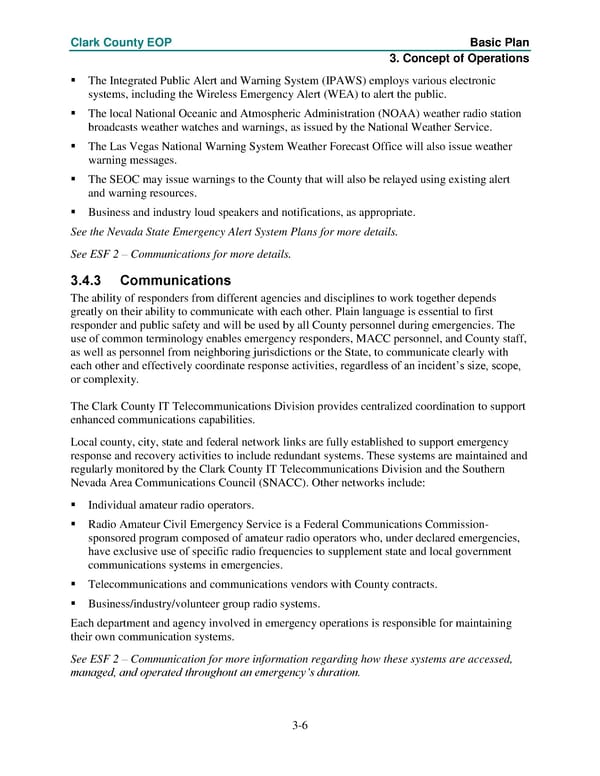Clark County EOP Basic Plan 3. Concept of Operations The Integrated Public Alert and Warning System (IPAWS) employs various electronic systems, including the Wireless Emergency Alert (WEA) to alert the public. The local National Oceanic and Atmospheric Administration (NOAA) weather radio station broadcasts weather watches and warnings, as issued by the National Weather Service. The Las Vegas National Warning System Weather Forecast Office will also issue weather warning messages. The SEOC may issue warnings to the County that will also be relayed using existing alert and warning resources. Business and industry loud speakers and notifications, as appropriate. See the Nevada State Emergency Alert System Plans for more details. See ESF 2 – Communications for more details. 3.4.3 Communications The ability of responders from different agencies and disciplines to work together depends greatly on their ability to communicate with each other. Plain language is essential to first responder and public safety and will be used by all County personnel during emergencies. The use of common terminology enables emergency responders, MACC personnel, and County staff, as well as personnel from neighboring jurisdictions or the State, to communicate clearly with each other and effectively coordinate response activities, regardless of an incident’s size, scope, or complexity. The Clark County IT Telecommunications Division provides centralized coordination to support enhanced communications capabilities. Local county, city, state and federal network links are fully established to support emergency response and recovery activities to include redundant systems. These systems are maintained and regularly monitored by the Clark County IT Telecommunications Division and the Southern Nevada Area Communications Council (SNACC). Other networks include: Individual amateur radio operators. Radio Amateur Civil Emergency Service is a Federal Communications Commission- sponsored program composed of amateur radio operators who, under declared emergencies, have exclusive use of specific radio frequencies to supplement state and local government communications systems in emergencies. Telecommunications and communications vendors with County contracts. Business/industry/volunteer group radio systems. Each department and agency involved in emergency operations is responsible for maintaining their own communication systems. See ESF 2 – Communication for more information regarding how these systems are accessed, managed, and operated throughout an emergency’s duration. 3-6
 Emergency Operations Plan Page 48 Page 50
Emergency Operations Plan Page 48 Page 50